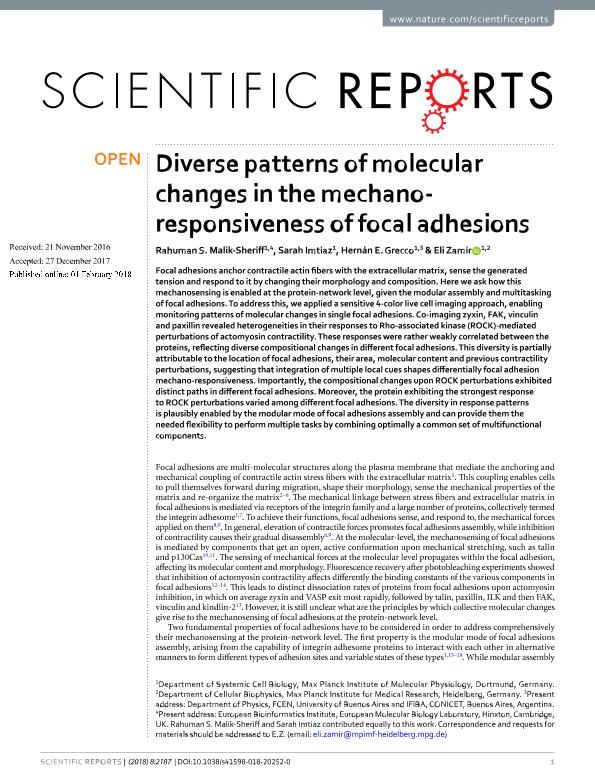Mostrar el registro sencillo del ítem
dc.contributor.author
Malik Sheriff, Rahuman S.
dc.contributor.author
Imtiaz, Sarah
dc.contributor.author
Grecco, Hernan Edgardo

dc.contributor.author
Zamir, Eli
dc.date.available
2020-02-18T22:21:04Z
dc.date.issued
2018-12
dc.identifier.citation
Malik Sheriff, Rahuman S.; Imtiaz, Sarah; Grecco, Hernan Edgardo; Zamir, Eli; Diverse patterns of molecular changes in the mechano-responsiveness of focal adhesions; Nature Publishing Group; Scientific Reports; 8; 1; 12-2018; 1-15
dc.identifier.issn
2045-2322
dc.identifier.uri
http://hdl.handle.net/11336/98019
dc.description.abstract
Focal adhesions anchor contractile actin fibers with the extracellular matrix, sense the generated tension and respond to it by changing their morphology and composition. Here we ask how this mechanosensing is enabled at the protein-network level, given the modular assembly and multitasking of focal adhesions. To address this, we applied a sensitive 4-color live cell imaging approach, enabling monitoring patterns of molecular changes in single focal adhesions. Co-imaging zyxin, FAK, vinculin and paxillin revealed heterogeneities in their responses to Rho-associated kinase (ROCK)-mediated perturbations of actomyosin contractility. These responses were rather weakly correlated between the proteins, reflecting diverse compositional changes in different focal adhesions. This diversity is partially attributable to the location of focal adhesions, their area, molecular content and previous contractility perturbations, suggesting that integration of multiple local cues shapes differentially focal adhesion mechano-responsiveness. Importantly, the compositional changes upon ROCK perturbations exhibited distinct paths in different focal adhesions. Moreover, the protein exhibiting the strongest response to ROCK perturbations varied among different focal adhesions. The diversity in response patterns is plausibly enabled by the modular mode of focal adhesions assembly and can provide them the needed flexibility to perform multiple tasks by combining optimally a common set of multifunctional components.
dc.format
application/pdf
dc.language.iso
eng
dc.publisher
Nature Publishing Group

dc.rights
info:eu-repo/semantics/openAccess
dc.rights.uri
https://creativecommons.org/licenses/by-nc-sa/2.5/ar/
dc.subject
Focal adhesions
dc.subject
Optical Imaging
dc.subject.classification
Biología Celular, Microbiología

dc.subject.classification
Ciencias Biológicas

dc.subject.classification
CIENCIAS NATURALES Y EXACTAS

dc.subject.classification
Óptica

dc.subject.classification
Ciencias Físicas

dc.subject.classification
CIENCIAS NATURALES Y EXACTAS

dc.title
Diverse patterns of molecular changes in the mechano-responsiveness of focal adhesions
dc.type
info:eu-repo/semantics/article
dc.type
info:ar-repo/semantics/artículo
dc.type
info:eu-repo/semantics/publishedVersion
dc.date.updated
2019-10-22T18:01:25Z
dc.journal.volume
8
dc.journal.number
1
dc.journal.pagination
1-15
dc.journal.pais
Reino Unido

dc.journal.ciudad
Londres
dc.description.fil
Fil: Malik Sheriff, Rahuman S.. Institut Max Planck fur Molekulare Physiologie; Alemania
dc.description.fil
Fil: Imtiaz, Sarah. Institut Max Planck fur Molekulare Physiologie; Alemania
dc.description.fil
Fil: Grecco, Hernan Edgardo. Consejo Nacional de Investigaciones Científicas y Técnicas. Oficina de Coordinación Administrativa Ciudad Universitaria. Instituto de Física de Buenos Aires. Universidad de Buenos Aires. Facultad de Ciencias Exactas y Naturales. Instituto de Física de Buenos Aires; Argentina. Institut Max Planck fur Molekulare Physiologie; Alemania
dc.description.fil
Fil: Zamir, Eli. Institut Max Planck fur Molekulare Physiologie; Alemania
dc.journal.title
Scientific Reports
dc.relation.alternativeid
info:eu-repo/semantics/altIdentifier/doi/http://dx.doi.org/10.1038/s41598-018-20252-0
dc.relation.alternativeid
info:eu-repo/semantics/altIdentifier/url/https://www.nature.com/articles/s41598-018-20252-0
Archivos asociados
